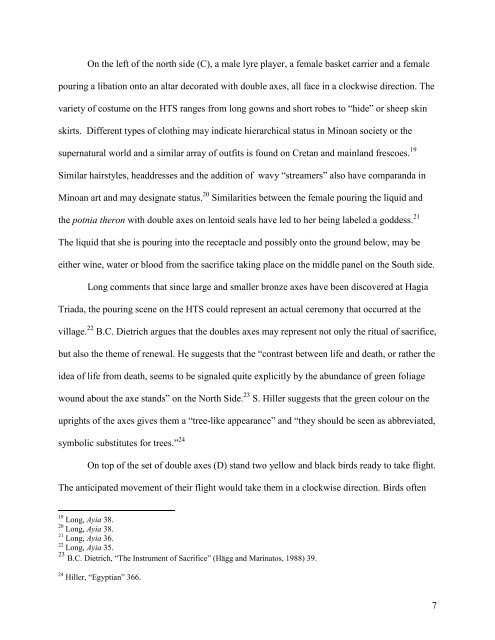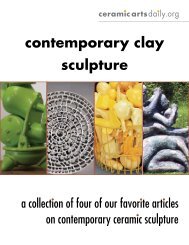Narrative Cycles on the Hagia Triada Sarcophagus - Wendy Walgate
Narrative Cycles on the Hagia Triada Sarcophagus - Wendy Walgate
Narrative Cycles on the Hagia Triada Sarcophagus - Wendy Walgate
- No tags were found...
You also want an ePaper? Increase the reach of your titles
YUMPU automatically turns print PDFs into web optimized ePapers that Google loves.
On <strong>the</strong> left of <strong>the</strong> north side (C), a male lyre player, a female basket carrier and a femalepouring a libati<strong>on</strong> <strong>on</strong>to an altar decorated with double axes, all face in a clockwise directi<strong>on</strong>. Thevariety of costume <strong>on</strong> <strong>the</strong> HTS ranges from l<strong>on</strong>g gowns and short robes to “hide” or sheep skinskirts. Different types of clothing may indicate hierarchical status in Minoan society or <strong>the</strong>supernatural world and a similar array of outfits is found <strong>on</strong> Cretan and mainland frescoes. 19Similar hairstyles, headdresses and <strong>the</strong> additi<strong>on</strong> of wavy “streamers” also have comparanda inMinoan art and may designate status. 20 Similarities between <strong>the</strong> female pouring <strong>the</strong> liquid and<strong>the</strong> potnia <strong>the</strong>r<strong>on</strong> with double axes <strong>on</strong> lentoid seals have led to her being labeled a goddess. 21The liquid that she is pouring into <strong>the</strong> receptacle and possibly <strong>on</strong>to <strong>the</strong> ground below, may beei<strong>the</strong>r wine, water or blood from <strong>the</strong> sacrifice taking place <strong>on</strong> <strong>the</strong> middle panel <strong>on</strong> <strong>the</strong> South side.L<strong>on</strong>g comments that since large and smaller br<strong>on</strong>ze axes have been discovered at <strong>Hagia</strong><strong>Triada</strong>, <strong>the</strong> pouring scene <strong>on</strong> <strong>the</strong> HTS could represent an actual cerem<strong>on</strong>y that occurred at <strong>the</strong>village. 22 B.C. Dietrich argues that <strong>the</strong> doubles axes may represent not <strong>on</strong>ly <strong>the</strong> ritual of sacrifice,but also <strong>the</strong> <strong>the</strong>me of renewal. He suggests that <strong>the</strong> “c<strong>on</strong>trast between life and death, or ra<strong>the</strong>r <strong>the</strong>idea of life from death, seems to be signaled quite explicitly by <strong>the</strong> abundance of green foliagewound about <strong>the</strong> axe stands” <strong>on</strong> <strong>the</strong> North Side. 23 S. Hiller suggests that <strong>the</strong> green colour <strong>on</strong> <strong>the</strong>uprights of <strong>the</strong> axes gives <strong>the</strong>m a “tree-like appearance” and “<strong>the</strong>y should be seen as abbreviated,symbolic substitutes for trees.” 24On top of <strong>the</strong> set of double axes (D) stand two yellow and black birds ready to take flight.The anticipated movement of <strong>the</strong>ir flight would take <strong>the</strong>m in a clockwise directi<strong>on</strong>. Birds often19 L<strong>on</strong>g, Ayia 38.20 L<strong>on</strong>g, Ayia 38.21 L<strong>on</strong>g, Ayia 36.22 L<strong>on</strong>g, Ayia 35.23 B.C. Dietrich, “The Instrument of Sacrifice” (Hägg and Marinatos, 1988) 39.24 Hiller, “Egyptian” 366.7





